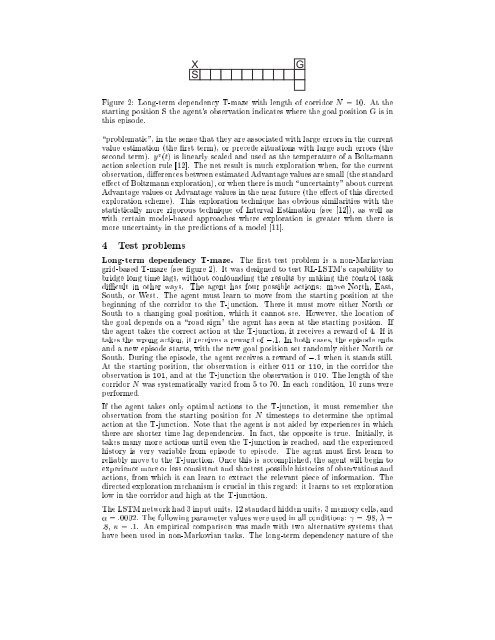Reinforcement Learning with Long Short-Term Memory
Reinforcement Learning with Long Short-Term Memory
Reinforcement Learning with Long Short-Term Memory
Create successful ePaper yourself
Turn your PDF publications into a flip-book with our unique Google optimized e-Paper software.
X<br />
S<br />
G<br />
Figure 2: <strong>Long</strong>-term dependency T-maze <strong>with</strong> length of corridor N = 10. At the<br />
starting position S the agent's observation indicates where the goal position G is in<br />
this episode.<br />
\problematic", in the sense that they are associated <strong>with</strong> large errors in the current<br />
value estimation (the rst term), or precede situations <strong>with</strong> large such errors (the<br />
second term). y v (t) is linearly scaled and used as the temperature of a Boltzmann<br />
action selection rule [12]. The net result is much exploration when, for the current<br />
observation, dierences between estimated Advantage values are small (the standard<br />
eect of Boltzmann exploration), or when there is much \uncertainty" about current<br />
Advantage values or Advantage values in the near future (the eect of this directed<br />
exploration scheme). This exploration technique has obvious similarities <strong>with</strong> the<br />
statistically more rigorous technique of Interval Estimation (see [12]), as well as<br />
<strong>with</strong> certain model-based approaches where exploration is greater when there is<br />
more uncertainty in the predictions of a model [11].<br />
4 Test problems<br />
<strong>Long</strong>-term dependency T-maze. The rst test problem is a non-Markovian<br />
grid-based T-maze (see gure 2). It was designed to test RL-LSTM's capability to<br />
bridge long time lags, <strong>with</strong>out confounding the results by making the control task<br />
dicult in other ways. The agent has four possible actions: move North, East,<br />
South, or West. The agent must learn to move from the starting position at the<br />
beginning of the corridor to the T-junction. There it must move either North or<br />
South to a changing goal position, which it cannot see. However, the location of<br />
the goal depends on a \road sign" the agent has seen at the starting position. If<br />
the agent takes the correct action at the T-junction, it receives a reward of 4. If it<br />
takes the wrong action, it receives a reward of ,:1. In both cases, the episode ends<br />
and a new episode starts, <strong>with</strong> the new goal position set randomly either North or<br />
South. During the episode, the agent receives a reward of ,:1 when it stands still.<br />
At the starting position, the observation is either 011 or 110, in the corridor the<br />
observation is 101, and at the T-junction the observation is 010. The length of the<br />
corridor N was systematically varied from 5 to 70. In each condition, 10 runs were<br />
performed.<br />
If the agent takes only optimal actions to the T-junction, it must remember the<br />
observation from the starting position for N timesteps to determine the optimal<br />
action at the T-junction. Note that the agent is not aided by experiences in which<br />
there are shorter time lag dependencies. In fact, the opposite is true. Initially, it<br />
takes many more actions until even the T-junction is reached, and the experienced<br />
history is very variable from episode to episode. The agent must rst learn to<br />
reliably move to the T-junction. Once this is accomplished, the agent will begin to<br />
experience more or less consistent and shortest possible histories of observations and<br />
actions, from which it can learn to extract the relevant piece of information. The<br />
directed exploration mechanism is crucial in this regard: it learns to set exploration<br />
low in the corridor and high at the T-junction.<br />
The LSTM network had 3 input units, 12 standard hidden units, 3 memory cells, and<br />
= :0002. The following parameter values were used in all conditions: = :98, =<br />
:8, = :1. An empirical comparison was made <strong>with</strong> two alternative systems that<br />
have been used in non-Markovian tasks. The long-term dependency nature of the
















